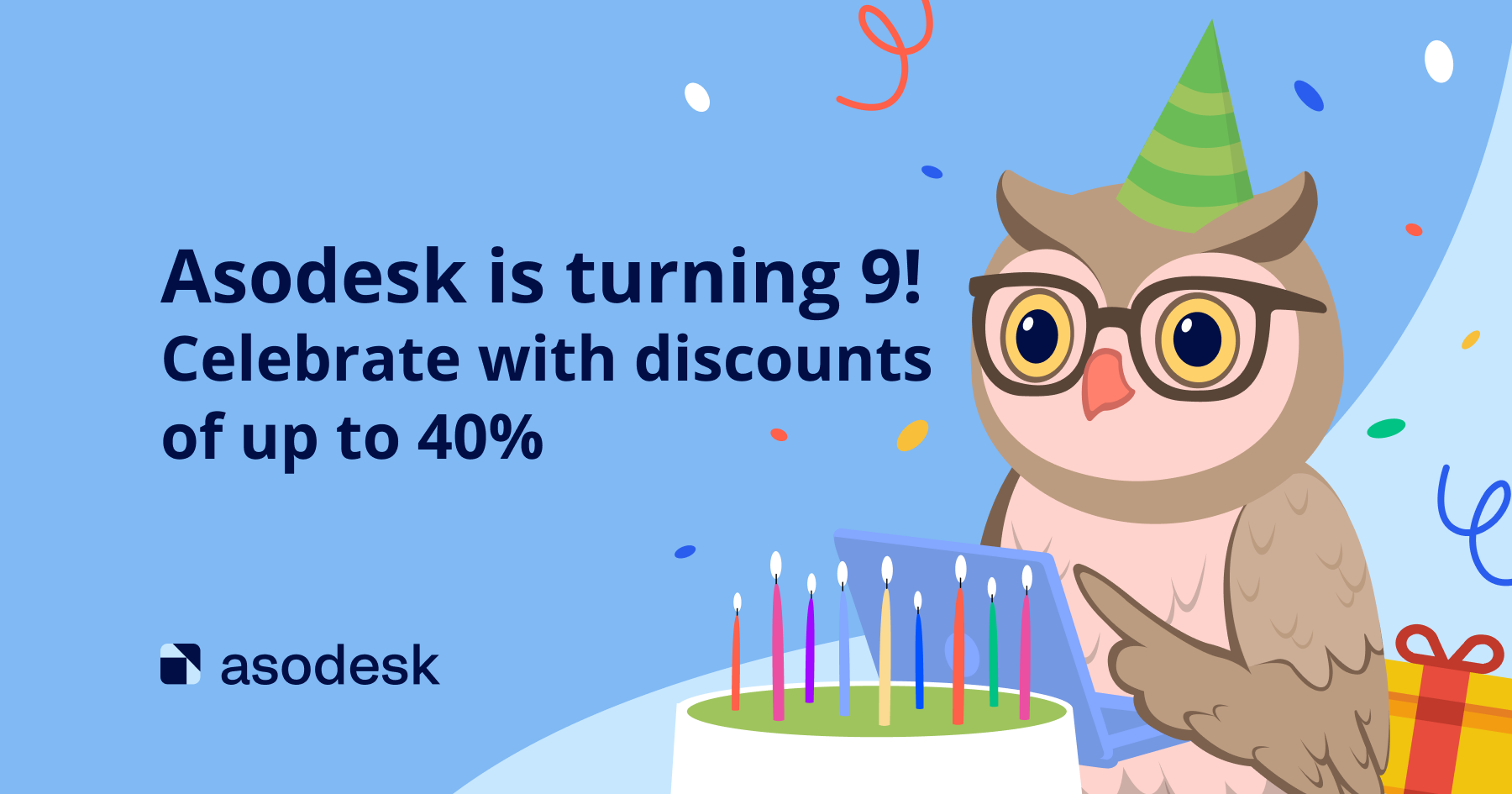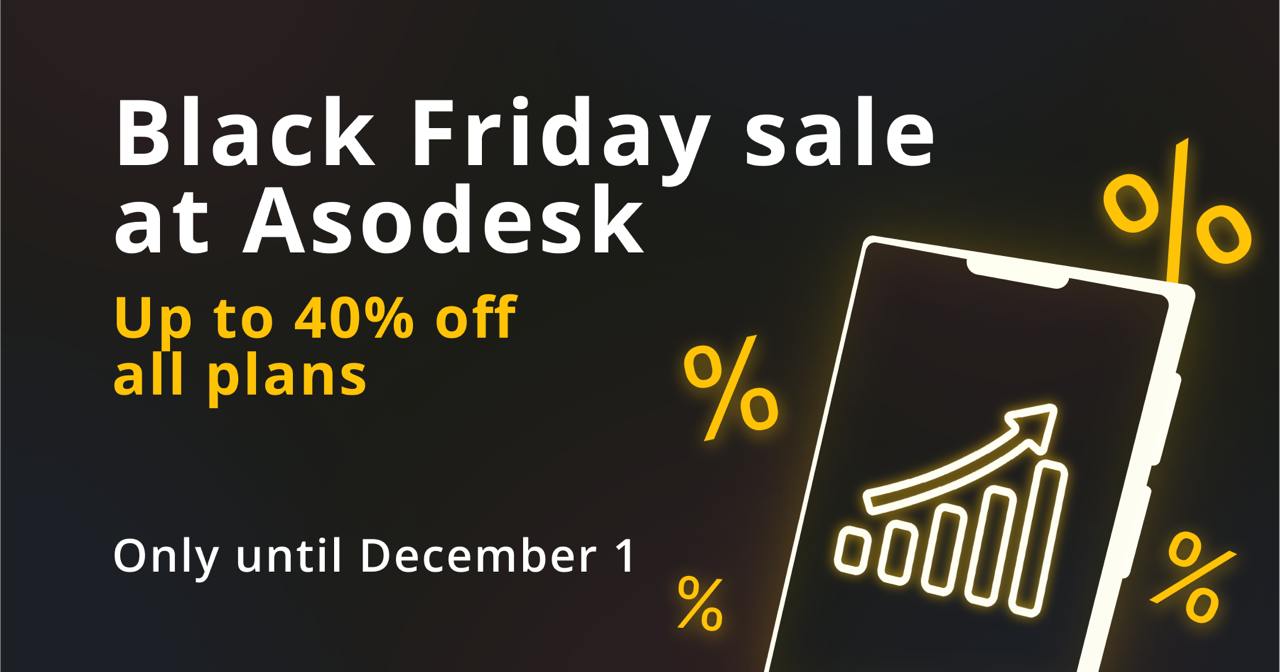How gaming businesses work with Organic User Acquisition and Conversion Rate Optimization in 2021
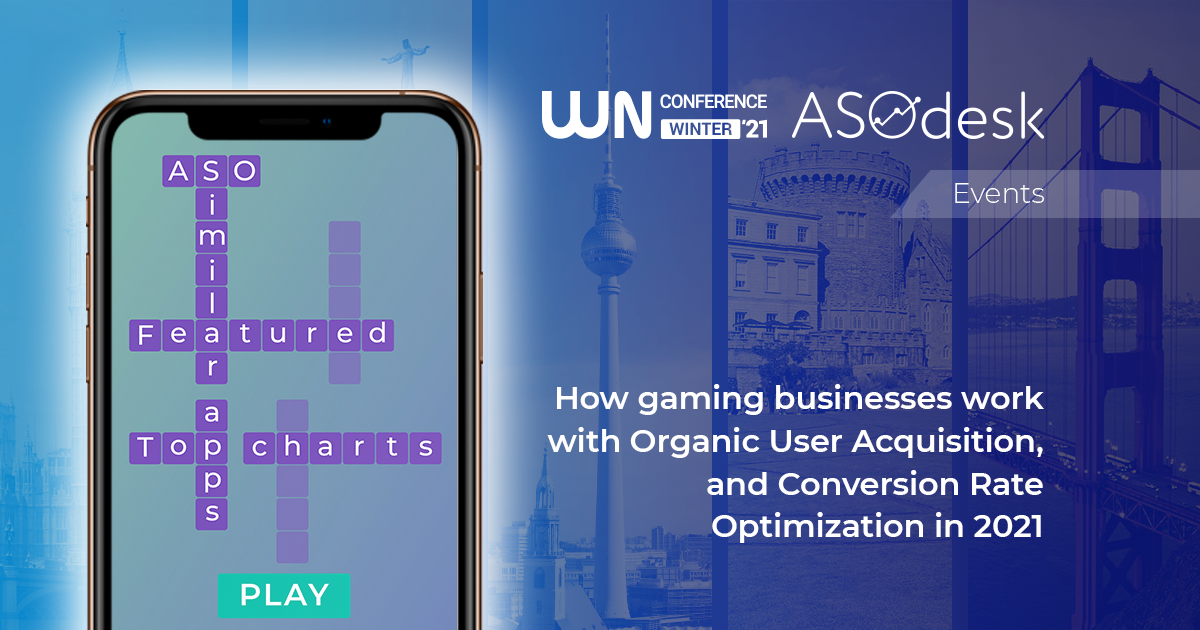
We have prepared an article based on MY.GAMES and ASOdesk’s speech at the WN Conference. Artiom Tkachuk spoke on how to choose a game category using ASOdesk’s research on the amount of non-branded traffic in different categories. Julia Shiriaeva and Anna Shopina gave recommendations on working with organic traffic and shared case studies.
To increase the number of installs, it is not enough to only conduct ASO. You should aim to get into the Top Charts, Similar Apps, and Suggested Apps. But before working with organic traffic, you need to choose the right category for a new game and a strategy for promoting an existing application.
In this article, Artiom Tkachuk will tell you which game categories are dominated by non-branded traffic. Julia Shiriaeva and Anna Shopina will give recommendations on how to use all user acquisition channels from app stores, choose languages for game localization, and which KPIs will help evaluate App Store and Google Play optimization effectiveness
Categories of games with the most branded and non-branded traffic

ASO Expert at ASOdesk
It is important to understand the number and percentage of non-branded searches across different categories of gaming applications and different countries. After all, the more non-branded traffic, the easier it will be for a new game to advance in search.
We looked at the amount of branded and non-branded traffic for 16 categories in 5 countries: USA, Russia, Germany, France, Spain. They also estimated the growth in the popularity of search queries in each category compared to 2020.
In the US, Germany, and France, the percentage of branded and non-branded search traffic is roughly the same. Branded search queries are more common in Russia (about 57%) and Spain (about 62%).

Based on the data obtained, we made the following conclusions:
1. For gaming applications in the family category, it will be easier to progress in the App Store, since they do not have to compete with strong brands. More than 55% of queries are non-branded in these categories in all the countries we reviewed. We see over 55% of non-branded searches in the card and word categories in 4 countries and the racing and board categories in 3 countries. These categories also hold some of the leading positions in terms of the number of non-branded searches in the countries we reviewed.
2. App Store Optimization will not be enough to promote games in the action, adventure, strategy, and simulation categories. Branded traffic for these categories makes up more than 60% of traffic in 4–5 of the countries we reviewed. To promote games in these categories, it is important to invest in brand development: promotion through social networks, advertising, and working with bloggers.
In the full study, you will find detailed statistics on the amount of non-branded and branded traffic for five countries, as well as data on the dynamics of the ASA Popularity indicator.
The number of organic installs in the App Store and Google Play
To build the right ASO strategy, it is important to understand which traffic source is prioritized for the game. Based on data from 25 MY.GAMES games, we can conclude that Search traffic is a priority traffic source for the App Store, while for Google Play it is Explore Traffic.
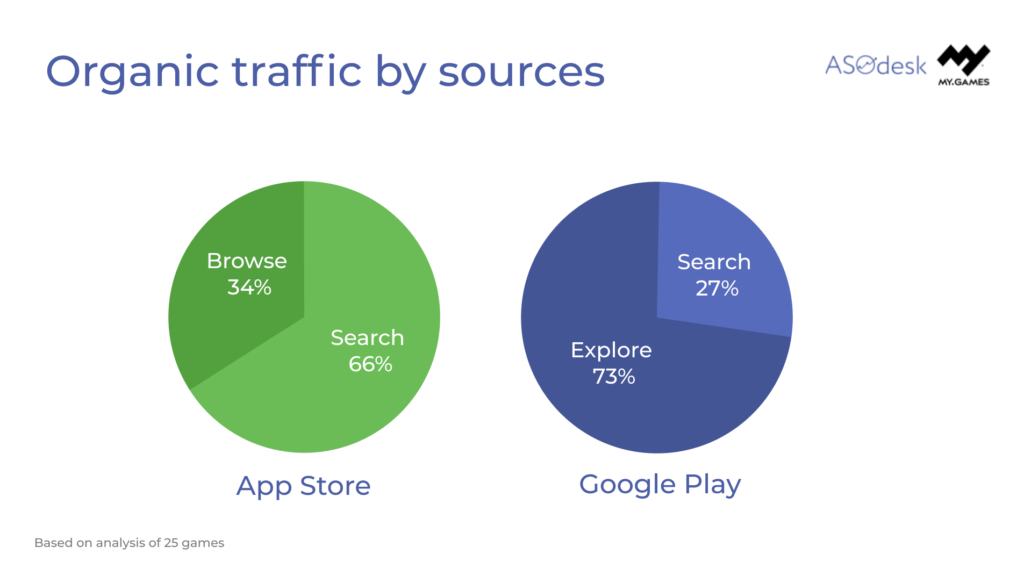
Search traffic is generated when a user types their query into the app stores’ search bar. Browse and Explore Traffic come from categories, Featured, and Similar Apps.
We see an interesting trend: in the App Store, 66% of installs come from search, while on Google Play it’s only 27%.
In order to ensure a positive result from working with all traffic sources, see MY.GAMES’ recommendations for working with ASO and Explore Traffic.
Gaming application ASO

ASO Lead at MY.GAMES
These guidelines will help you make your ASO more effective:
1. Focus on textual optimization and search rankings. There is no magic formula for a game to be in the top 1 or top 3 right after you just updated the metadata. It’s important to do the optimization several times, experiment with different variations of keywords, and find the combination that puts you in the top 10.
Note from the editor: For more information on why you need to do several iterations to reach the top, read this ASOdesk article.
2. Where possible, update your metadata every 2–3 weeks. If in 2–3 weeks the application has not reached the top 10 for certain queries, it makes sense to try new keywords in the metadata.
3. Improve your Google Play view-to-install conversion rate with comprehensive Keyword Optimization (KWO) and Conversion Rate Optimization (CRO). Targeted queries can be displayed on the icon, in screenshots, or the textual part of the metadata, so that users find your application more often and hesitate as little as possible — ultimately installing the game faster.
4. Add new keywords to the semantic core based on the seasonal and situational context. For example, the popular TV series, The Queen’s Gambit has increased users’ interest in chess. You can add keywords related to the series to the semantic core. It does not necessarily mean that your game is related to chess; puzzles are also suitable. If your game is related to football, you can add the phrase “The UEFA Super Cup” to your keywords in the run-up to the Super Cup.
The main thing is to act quickly before the niche becomes too competitive, and events are no longer relevant.
Note from the editor: It is important to keep track of current and popular queries in order to add them to the semantic core in time. This can be done using ASOdesk’s Trending Searches report. It allows you to track daily queries that are gaining popularity in different countries.
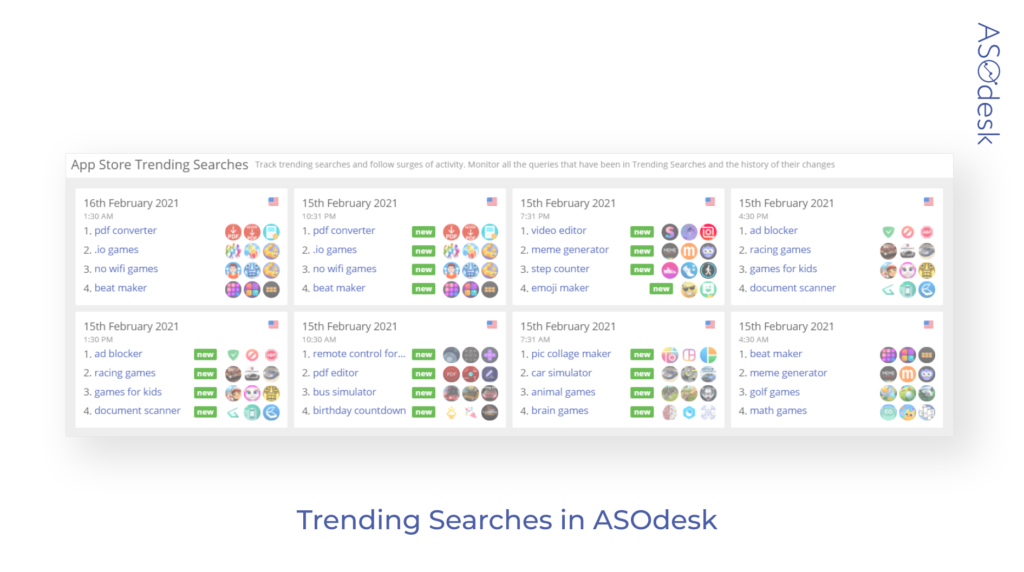

5. Refresh the graphical elements of the application page every 2–6 weeks. Users get tired not only of ads but also of the same apps in search results. Therefore, it is important to add new visual elements to the game: this will attract more attention and make you stand out from the competition.
6. Focus on the keywords for which your game is in the top 10. Keyword ranking mainly depends on how often users install the game for a specific query. So try placing these keywords in the title, subtitle, icon, and screenshots.
Let’s look at the game Battle Arena as an example. After adding the keyword “RPG” to the icon, installs went up by 45%, according to Google Play Experiment.
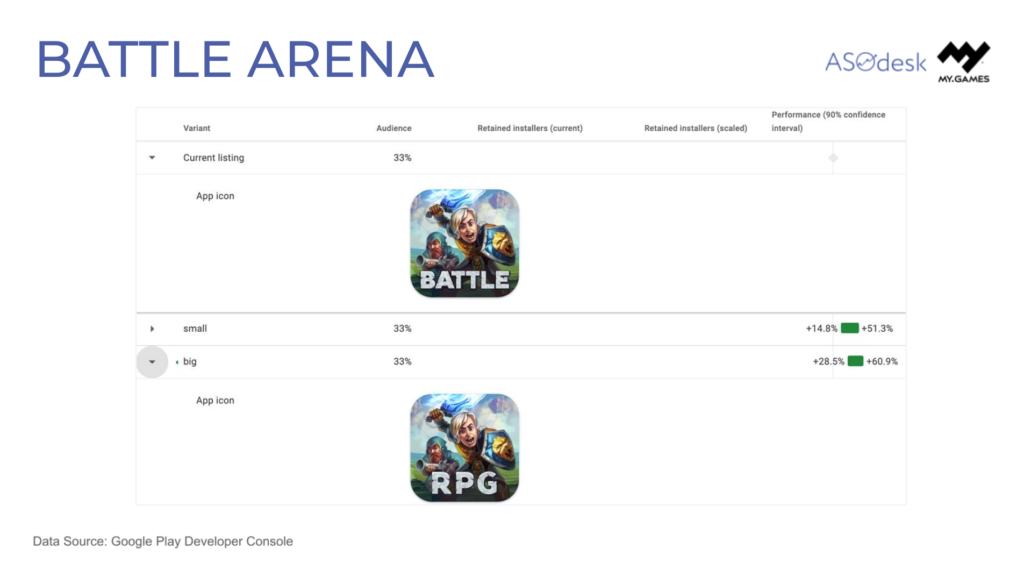
So, in order to reach the top and increase the install conversion rate, it is important to engage in ASO regularly, add seasonal keywords to the metadata, update visual elements every 2–3 weeks, and experiment with keywords on the app icon.
Working with Explore Traffic

ASO Manager at MY.GAMES
Since 73% of traffic on Google Play is Explore Traffic, you need to know how to work with it. On Google Play, your game can be in Featured, or appear in the Top Charts and Similar Apps.
For a game to get featured or reach the top charts, it’s important to follow a few general tips:
1. Pay attention to the quality of your game. Firstly, the game needs to provide users with a great user experience. And secondly, it should be regularly updated and not suffer from any kinds of bugs.
2. Work with ratings. App store editors generally don’t even consider a score below 4–4.5. Therefore, it is important to work on improving the app’s rating. Adequate responses to reviews contribute significantly to this.
Note from the editor: In this ASOdesk article, you can find 9 hacks that will make working with user reviews more efficient.
3. Add as much information about the game as possible to screenshots and videos. The most important are the first two screenshots, which show the main features of your game.
4. Use seasonal creative strategies, as they will help your game get into the stores’ special compilations like the best games for Christmas or Halloween.
5. Follow all platform recommendations, such as the launch checklists for Google Play developers.
6. Adapt the game for other countries. The more localizations the game has, the higher your chances of getting featured globally.
In addition to the listed points, in order to get into the top charts, it is also important to:
1. Choose the most popular category with the least competition. You can always change the category on Google Play Console. If you don’t know what the “perfect” category for your app is, you can always test some categories, collect download data, and make the right decision.
2. Increase the volume of installs and work to maximize your Retention Rate. App stores pay attention to these metrics when choosing a game, so it’s important to work with them.
In order to get into the Top Charts and Featured, it is important to constantly work on product quality, localize the application in several countries, take into account the recommendations of the app stores, improve ratings, track reviews, work on your Retention Rate, and increase the total volume of installs.
Similar Apps

ASO Manager at MY.GAMES
Similar Apps on Google Play are another supplementary means for increasing traffic. To get into Similar Apps, use a few simple tips:
1. Find out how Google categorizes your game. Use API GNL to see how Google categorizes your game.
API Google Natural Language is a tool that, through text interpretation, tells us how Google categorizes our game within all Google categories. It helps to adapt the text to the category in which you’d like to appear. Your category should correspond with your main competitor’s category. This will increase your chances of appearing in Similar Apps of your competitors.
Note from the editor: You can learn more about working with API GNL in this lecture by Artiom Tkachuk.
2. Create similar visuals. As we already know, Google algorithms scan not only text but also visuals. So if you want your game to appear in Similar Apps of your competitors try to create similar visual features. It can boost your positions in Similar Apps.
3. It is important to work on improving ratings and reviews. Additionally, the overall volume of installs also affects an app’s visibility in Similar Apps. As a rule, Similar Apps show applications with a similar traffic volume. That is, the more installs you get, the higher the chance of appearing in Similar Apps for a more major competitor. Internal metrics such as Retention Rate, the number of bugs, and uninstalls, also have a significant impact on visibility. You need to constantly work on them.

Let’s discuss the game Warface Global Operations as an example. On the graph, you can see that the game’s Similar Apps visibility before the full description update was quite unstable.
But after we worked through the full description and the API Google natural language to better match the category of our competitors, our visibility became more stable.
After an update, we can see a drop, which we attribute to the indexing of a full description. But then, after a month we achieved a five percent growth in Explore Traffic. For Warface, which has thousands of downloads, it is a quite significant result.
ASO and paid user acquisition

ASO Lead at MY.GAMES
Games usually have a large budget to boost paid traffic. Here is how you can use paid traffic to enhance the effect of ASO:
1. Add only recognizable characters to your ad. This will prevent users from confusing your game with other games or receiving an incorrect message.
2. Increase the relevance of your ASA ads by adding the same keywords to your metadata. In the latest version of ASA Advanced, keywords are set manually. Apple scans the page for relevance, so it needs to contain the same keywords used in the metadata. Otherwise, getting the same number of views will be more expensive.
3. Create different sets of screenshots for different keywords to increase the conversion rate (CR). You can upload up to 10 screenshots to the app store page and adapt them for keywords.
4. Adapt the app page for the keywords you want to use to improve your position after launching an advertising campaign. On Google Play and the App Store, the number of installs affects Keyword Ranking. Therefore, you need to work on getting impressions for more keywords.
5. Maintain close communication within the team. ASO and ad managers should consult and interact with each other when planning ad campaigns. It is important to ensure that the information in the ad matches the information on the application page.
6. Keep relevant keywords in the metadata to maximize the K-factor. Before you start any paid campaigns, make sure the metadata contains all the targeted queries that you would like to grow organically for. Additional traffic will help you with this, and working on conversion will help you maintain search positions.
Certain actions might negatively affect ASO and advertising results. Here are some important tips:
1. Don’t avoid communication with UA teams. There might be an occurrence that affects ASO, KPIs, and installs, so it is important to share it with the whole team. For example, a large campaign can change the results of experiments on Google Play. To avoid misunderstandings and to know what changes have occurred due to a paid team or ASO, it is important to communicate with colleagues.
2. Don’t stop using creative sets that have shown good results for the UA team in paid companies. These kits can be used for future advertising campaigns, and similar ideas can be added to screenshots.
3. Don’t display misleading ads. These kinds of ads do work, but you need to be very careful with them. It is important to monitor your KPIs and internal metrics: Retention Rate, Daily Active Users and Monthly Active Users.
Let’s look at our case study on Hustle Castel. We’ve added an icon with a popular “pin” feature that wasn’t actually used in the game. Despite the growth in installs, the Organic Retention Rate dropped immediately after the update.

Therefore, if retention is more important to you than attracting installs, you need to do the update more carefully and monitor all significant metrics.
For ASO and paid traffic to work effectively, communication between ASO specialists and advertising managers is important. You need to take into account the experience of previous paid campaigns, use similar creative decisions in screenshots and ads, and only add recognizable game characters to ads.
Game localization

ASO Manager at MY.GAMES
Mobile Games Localization is a great way to increase your game downloads because there are many countries where people would likely prefer localized games that they can understand and relate to.
It is important to consider several factors when choosing a language for localization. First, remember to localize in markets with the highest revenue market share because the markets with the highest download share are not always generating the highest revenue. If the market is big but you feel as though users won’t pay for the game, it is not worth localizing.
In the graph, we have shown the most popular languages for localizing games according to data from LocalizeDirect.

Secondly, as you can see on the graph, FIGS (French, Italian, German, Spanish) are very popular in-game localization and are vital to the growth of games on an international level. So, If you are just starting to localize your game, FIGS languages would be where to start.
If your game is already localized for FIGS and you are looking for new markets, we recommend such languages as:
- Japanese
- Brazilian Portuguese
- Russian
- Korean
- Turkish
- Polish
Moreover, when you are working with conversion rate optimization and organic user acquisition, don’t forget about visual assets localization.
Pay attention to the visuals of local competitors and category trends, personalize visuals for your audience and support seasonal events in your target countries. This can help increase your install conversion rates in different markets.
Take a look at the example of our game Hustle Castle. We have made a new localized video for the Japanese market, taking into account the cultural characteristics of the country. On the graph, you can see that our number of search installs in Japan has quadrupled.

So, when working with graphical optimization, it is important not only to adapt the application and its page description in the App Store and Google Play but also to take into account local characteristics and cultural traditions. This will have a positive effect on your conversion rate and overall install volume.
KPIs for gaming applications

ASO Manager at MY.GAMES
To make the process of measuring optimization performance easier, we’ll share the most important KPIs for games in the App Store and Google Play with you.

Indicators for the App Store:
1. Keyword Ranking can always show us if our keyword update was successful or not.
2. Search installs by country indicate the effectiveness of textual and visual updates in each market.
3. Search Conversion Rate (Search CR) measures how well your metadata is contributing to user engagement. This is especially important for graphical optimization.
4. Browse installs help us to measure the effectiveness of being a featured game.
5. Reviews and ratings can impact search page and product page conversion rates. Especially if it is a new game without a strong brand name.
6. Apple Search Ads Conversion Rate (ASA CR) measures the performance of your ads. To improve this metric, you can experiment with Creative Sets, which shows the most important search queries or the most profitable keywords on the chart. This can help you increase CR for each keyword and lower your cost per tap (CPT).
Indicators for Google Play:
1. Tracking search positions helps to understand how effective the textual metadata update was.
2. Search Traffic and Explore Traffic CR help you evaluate the effectiveness of your graphics updates. Additionally, we check CR per keyword, for example, if we add a popular search query to the graphics, as in the case of Battle Arena.
3. Total organic installs by country helps to measure the effectiveness of ASO optimization in each market.
4. Categories & Similar App Visibility can show us the effectiveness of full description optimization and the results of visual asset optimizations, for example, when we are trying to appear in similar apps of our competitors.
5. Reviews & Ratings help to increase your install conversion rate and get into Featured, Top Charts, and Similar Apps. Therefore, it is important to track this indicator.
6. 1d Retention Rate is another metric that we take into account when conducting A/B testing in Google Experiments. It helps to understand how accurately new creative strategies convey the essence of the game.
It is important to consider all of the listed metrics in order to draw correct conclusions about the effectiveness of ASO and make predictions for the next iterations.
Conclusions
- When choosing a category for a new game or planning a strategy for promoting an existing app, it is important to consider the volume and percentage of non-branded traffic in the category.
- In Google Play and the App Store, a large percentage of users come from Browse and Explore Traffic. Therefore, it is important not only to work on ASO, but to get into Featured, Top Charts, and Similar Applications.
- Regularity is important in ASO: you need to monitor trending queries, add seasonal keywords, and update visuals every 2–6 weeks. Otherwise, users may get tired of seeing the same game page in the search.
- In order for an app to get featured, you need to work on its quality, improve its rating, consider the recommendations of the App Store and Google Play, adapt the app for several countries, and improve internal metrics and performance indicators.
- Constant communication between the ASO and advertising departments is essential. It will help to improve the effectiveness of ASO and paid user acquisition.
- Do localization for the countries that will bring you the greatest income. Consider holidays and events and reflect them in the visual elements of the game. This will help you increase your conversion rate.
- For successful optimization, assessing the number of installs and install conversion is not enough; you need to measure a number of indicators that will help you draw the right conclusions about the effectiveness of optimization.

